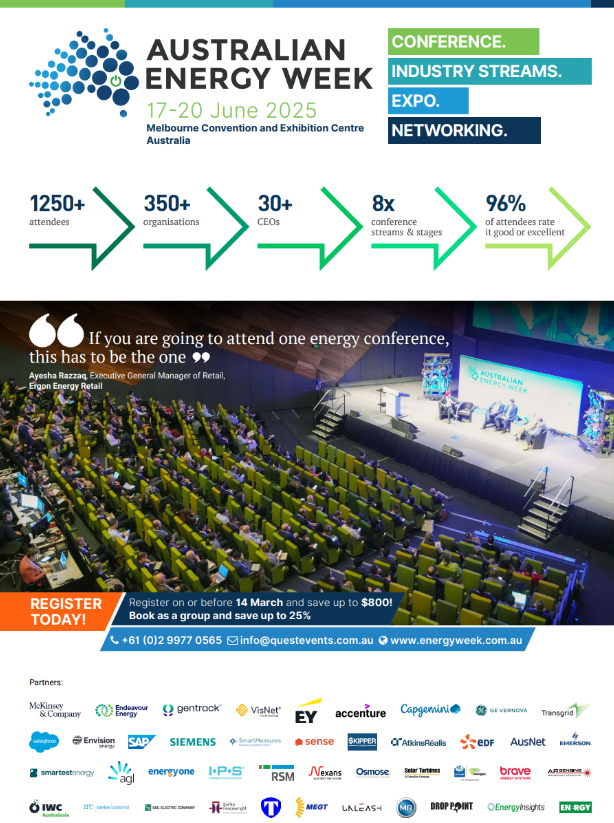Article: What’s the role of gas in the NEM?
By Rose Mary Petrass
Gas has long played a critical role in firming and reliability in Australia’s National Electricity Market (NEM). But its future is increasingly uncertain as emissions targets tighten, renewables grow, and gas prices remain volatile.
The International Energy Agency’s Electricity 2025 report projects global electricity demand will grow by 4% annually to 2027, with renewables meeting 95% of that growth. In the US and EU, renewables could soon meet 100% of demand.
In Australia, surging gas prices have pushed up electricity costs, casting doubt on affordability and competitiveness while batteries and renewables reshape how we ensure reliability. Meanwhile, Canberra’s net-zero plan raises questions about gas’s long-term role. Investors, too, are re-evaluating its future.
What role does gas play in the grid?
Currently accounting for 18-20% of total emissions, Tony Wood (Grattan Institute’s Energy Program Director) says some of the roles gas plays may soon disappear. But gas will still be needed for high-temperature industrial heat and as backup generation: “Maintaining a reliable energy supply is crucial for decarbonisation efforts, as a reliable grid is necessary for the broader transition.”
Investment appetite for gas is shifting: “While gas produces fewer greenhouse gases than coal, it still emits more than wind and solar,” Wood explains. “The challenge lies in providing investment confidence for new gas generation, as although gas may not run frequently, it will be needed when renewables are insufficient. Ensuring reliable gas supply in short volumes to the electricity grid is a significant investment challenge.”
Jemena’s GM Renewable Gas, Suzie Jakobovits, agrees gas is vital for manufacturing and firming renewables as coal retires. “It is imperative governments pull all the necessary policy levers to enable cost competitive natural and renewable gas,” she argues. “Gas has a crucial role to play in Australia’s energy mix now and into the future.”
Jill Cainey (Erne Energy) disagrees. She blames methane for keeping bills high and counteracting the cost benefits of wind and solar, because it acts as the price-setter in the NEM. “Methane is not competitive today, either as an electricity generation source or used directly to provide energy,” she says. “Methane is an outdated and legacy fuel source… Electrification is the future.” She references the Australian Energy Market Operator’s (AEMO) 2025 Gas Statement of Opportunities, which shows declining gas demand as homes and businesses electrify. We don’t need more gas, she says – regardless of the AEMO Integrated System Plan conclusions and
view the future is firmed by gas. Electrification and distributed energy resources are reducing the burden on the wider system, reducing the need for methane in the NEM. Added to this, Cainey says gas-dependant, high-heat process industries may still struggle to be competitive even if there is sufficient methane supply, because the price of methane is set internationally.
Angela Karl, who heads energy transition at HMC Capital sees a shift underway. As battery storage and long-duration storage solutions scale up, gas is increasingly confined to seasonal and transitional roles.
What innovations might keep gas relevant?
While Cainey argues methane and hydrogen are no longer viable, Wood sees potential in pairing gas with emerging technologies. Carbon capture and storage (CSS) and changes to gas trading could support emissions reductions. Some gas plants are trialling hydrogen blends to cut emissions. While green hydrogen remains expensive and technically challenging, Wood suggests blue hydrogen - produced from gas with CCS - could offer a temporary bridge.
Cainey rejects this: “It makes no sense to use renewable electricity to make hydrogen, when the renewable electricity can be used more efficiently directly.”
Jakobovits sees promise in biomethane. Compatible with existing infrastructure, it could lower emissions and support hard-to-electrify industries. She cites Denmark’s target of 100% biomethane injection by 2030 and Ireland’s goal for 100% renewable gas by 2045. Public-private partnerships could scale biomethane to meet industrial demand, she says, but stronger policy alignment is needed to boost investor confidence.
Can the NEM transition without gas?
With growing alternatives - batteries, pumped hydro, and demand response - is gas still needed? While some regions may phase out gas faster than others - for example, South Australia’s high renewable penetration versus Queensland’s reliance on gas - most of our experts warn of a risk of reliability shortfalls without it.
“Gas will continue to be necessary during peak demand,” Woods says. “The role of gas will evolve to support a high-renewable grid, providing flexibility when renewable sources are not generating power.”
Jakobovits agrees that while batteries can smooth daily peaks, gas remains the most economical option for long-duration firming - at least for now.
AEMO estimates that 15 GW of gas-powered generation is needed to ensure NEM reliability in a high-renewables future. With 9.3 GW of existing gas capacity expected to retire, that would require both replacement and additional new supply.
Karl believes gas plants will shift from daily use to seasonal roles.
Cainey thinks batteries are already price-competitive. “The footprint of a battery storage facility is smaller and quicker to build than a methane peaking plant today… We are likely to need more long-duration storage, which is why Tasmania’s ‘Battery of the Nation’ project and pumped hydro projects are so critical and why the Capacity Investment Scheme and the NSW incentive scheme focusing on long-duration storage is so important.”
Gas remains a hot topic, with strong debate surrounding its future role. Will gas be a necessity, or will Australia accelerate beyond it?
Tony Wood, Suzie Jakobovits, Jill Cainey and Angela Karl will be joined by gas users, retailers, distributors and energy commentators at Australian Energy Week 2025 to discuss the future energy mix. Learn more.
Download the Brochure


